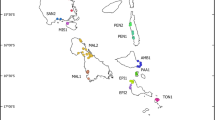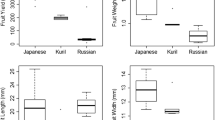Abstract
An understanding of the inter-relationships between the traits characterising tree-to-tree variation in fruits and kernels is fundamental to the development of selected cultivars based on multiple trait selection. Using data from previously characterised marula (Sclerocarya birrea) trees in Bushbuckridge, South Africa and North Central Region of Namibia, this study examines the relationships between the different traits (fruit pulp, flesh/juice mass, and nut shell and kernel mass) as a means to determine the opportunities to develop cultivars. Strong and highly significant relationships were found between fruit mass and pulp mass in trees from South Africa and Namibia, indicating that size is a good predictor of fruit pulp production. However, fruit size is not a good predictor of nut or kernel production, as there were weak relationships between fruit and nut and/or kernel mass, which varied between sites and landuses. Generally, the relationships between fruit mass and kernel mass were weaker than between fruit mass and nut mass. Relationships between kernel mass and shell mass were generally weak. The lack of strong relationships between fruit and kernel mass does, however, imply that there are opportunities to identify trees with either big fruits/small nuts for pulp production, or trees with large kernels in relatively small fruits for kernel oil production. However, within fruits from the same tree, nuts could contain 0–4 kernels, indicating that even in trees with an inherent propensity for large kernels, improved pollination may be required to maximise kernel mass through an increase in kernel number. Finally, the relationships between percentage kernel oil content and the measured morphological traits were also very weak. The conclusions of these results are that there is merit in identifying different combinations of traits for the selection of trees producing either pulp or kernels. Consequently, fruit and kernel ‘ideotypes’ are presented as guides to the selection of elite trees for cultivar development. These results have important implications for the domestication of the species as a producer of fruits or kernels for food/beverages or cosmetic oils.
Similar content being viewed by others
References
A.R. Atangana V. Ukafor P.O. Anegbeh E. Asaah Z. Tchoundjeu C. Usoro J-M. Fondoun M. Ndoumbe R.R.B. Leakey (2002) ArticleTitleDomestication of Irvingia gabonensis: 2. The selection of multiple traits for potential cultivars from Cameroon and Nigeria Agroforest. Syst. 55 221–229 Occurrence Handle10.1023/A:1020584823505
A. Botelle (2002) A survey of marula fruit yields in North-Central Namibia Report to UK DFID Forestry Research Programme (Project No R7795) CRIAA-SADC Windhoek, Namibia
E. Kengni Z. Tchoundjeu F.M. Tchouanguep C.M.F. Mbofung (2001) ArticleTitleSensory evaluation of Dacryodes edulis fruit types ForestTrees Liveli. 11 57–66
R.R.B Leakey (1999a) ArticleTitlePotential for novel food products from agroforestry trees: A review Food Chem. 66 IssueID1 1–14 Occurrence Handle10.1016/S0308-8146(98)00072-7 Occurrence Handle1:CAS:528:DyaK1MXislGqtb4%3D
R.R.B. Leakey (1999b) Agroforestry for biodiversity in farming systems, Biodiversity W.W. Collins C.O. Qualset (Eds) Agroecosystems CRC Press New York 127–145
R.R.B. Leakey (2001a) ArticleTitleWin:Win landuse strategies for Africa: 1. Building on experience with agroforests in Asia and Latin America Int. Forest. Rev. 3 1–10
R.R.B. Leakey (2001b) ArticleTitleWin:Win landuse strategies for Africa: 2. Capturing economic and environmental benefits with multistrata agroforests Int. Forest. Rev. 3 11–18
R.R.B. Leakey A.J. Simons (1998) ArticleTitleThe domestication and commercialisation of indigenous trees in agroforestry for the alleviation of poverty Agroforest. Syst. 38 165–176
R.R.B. Leakey A.R. Atangana E. Kengni A.N. Waruhiu C. Usoro Z. Tchoundjeu P.O. Anegbeh (2002) ArticleTitleDomestication of Dacryodes edulis in West and Central Africa: characterization of genetic variation ForestTrees Liveli. 12 57–71
R.R.B. Leakey K. Schreckenberg Z. Tchoundjeu (2003) ArticleTitleThe potential relevance in Latin America of the West African experience with participatory domestication of indigenous fruits Int. Forest. Rev. 5 338–347
Leakey R.R.B., Shackleton S. and du Plessis P. 2004a. Domestication potential of Marula (Sclerocarya birrea subsp caffra) in South Africa and Namibia: 1. Phenotypic variation in fruit traits. Agroforest. Syst. 64: 25–35. This volume.
Leakey R.R.B., Pate K. and Lombard C. 2005b. Domestication potential of Marula (Sclerocarya birrea subsp caffra) in South Africa and Namibia: 2. Phenotypic variation in nut and kernel traits. Agroforest. Syst. 64: 37–49. This volume.
J.A. Maghembe A.J. Simons F. Kwesiga M. Rarieya (1998) Selecting indigenous trees for domestication in southern Africa: priority setting with farmers in MalawiTanzaniaZambiam and Zimbabwe ICRAF NairobiKenya
T. McHardy (2002) Inventory of available marula resources on the Makhatini Flats Maputaland in the fruiting season of 2002, Report to UK DFID Forestry Research Programme (Project No R7795) Institute of Natural Resources ScottsvilleSouth Africa
C. Poulton N. Poole (2001) Poverty and fruit tree researchDFID Issues and Options PaperForestry research Programme Imperial College at Wye KentEngland
G. Schaefer A.E.G. McGill (1986) ArticleTitleFlavour profiling of juice of the marula (Sclerocarya birrea sub1sp. caffra) as an index for cultivar selection Acta Horticult. 194 215–222
S.E. Shackleton C.M. Shackleton A.B. Cunningham C. Lombard C.A. Sullivan T.R. Netshiluvhi (2002) ArticleTitleKnowledge on Sclerocarya birrea subsp. caffra with emphasis on its importance as a non-timber forest product in South and southern Africa: A summary, Part 1: taxonomy, ecology and role in rural livelihoods South. Afr. Forest. J. 194 27–41
S. Shackleton, R. Wynberg, C. Sullivan, C. Shackleton, R. Leakey, M. Mander, T. McHardy, S. den Adel, A. Botelle, P. du Plessis, C.Lombard, A. Combrinck, A. Cunningham, D. O Regan, S. Laird, 2003a Marula commercialisation for sustainable and equitable livelihoods: Synthesis of a southern African case study, Winners and Losers – Final Technical Report to DFID (FRP Project R7795). Volume 4, Appendix 3.5, 57p.
C.M. Shackleton J. Botha P.L. Emanuel (2003b) ArticleTitleProductivity and abundance of Sclerocarya birrea subsp. caffra in and around rural settlements and protected areas of the Bushbuckridge lowveldSouth Africa Forests, Trees Liveli. 13 217–232
A.J. Simons R.R.B. Leakey (2004) ArticleTitleTree domestication in tropical agroforestry Agroforest. Syst. 61 167–181 Occurrence Handle10.1023/B:AGFO.0000028997.74147.f9
Z. Tchoundjeu B. Duguma J-M. Foudoun J. Kengue (1998) ArticleTitleStrategy for the domestication of indigenous fruit trees of West Africa: case of Irvingia gabonensis in southern Cameroon Cameroon J. Biol. Biochem. Sci. 4 21–28
M.K. Thiong’o S. Kingori H. Jaenicke (2002) ArticleTitleThe taste of the wild: variation in the nutritional quality of marula fruits and opportunities for domestication Acta Horticulturae 575 237–244
R. Wynberg J. Cribbins R.R.B. Leakey C. Lombard M. Mander S.E. Shackleton C.A. Sullivan (2002) ArticleTitleKnowledge on Sclerocarya birrea subsp. caffra with emphasis on its importance as a non-timber forest product in South and southern Africa: A summary.Part 2. Commercial usetenure and policy, domestication, intellectual property rights and benefit-sharing South. Afr. Forest. J. 196 67–77
Author information
Authors and Affiliations
Corresponding author
Rights and permissions
About this article
Cite this article
Leakey, R. Domestication potential of Marula (Sclerocarya birrea subsp. caffra) in South Africa and Namibia: 3. Multiple trait selection. Agroforest Syst 64, 51–59 (2005). https://doi.org/10.1007/s10457-005-2480-7
Received:
Revised:
Accepted:
Issue Date:
DOI: https://doi.org/10.1007/s10457-005-2480-7




